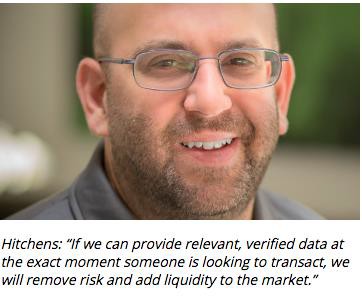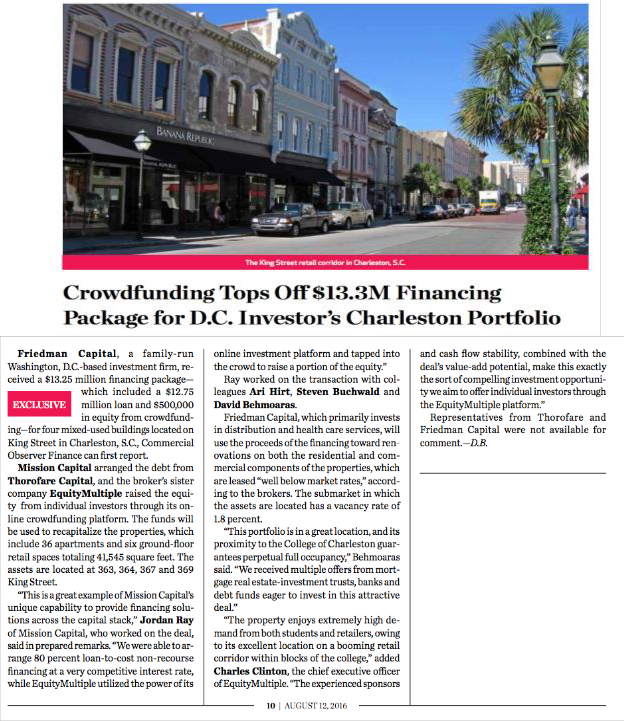Mission Capital’s David Tobin comments on the use of big data in the industry.

Big Data Alone Is Not Enough
AUGUST 19, 2016 | BY CARRIE ROSSENFELD
IRVINE, CA—Big data is not, by itself, inherently useful; information is only as valuable as its fusion with industry experience, Ten-X’s Sheridan Hitchens tells GlobeSt.com in this EXCLUSIVE roundtable about big data and the real estate industry.

IRVINE, CA—Big data is not, by itself, inherently useful; information is only as valuable as its fusion with industry experience, Ten-X’s VP of data products Sheridan Hitchens tells GlobeSt.com. We spoke
exclusively with Hitchens, along with Morgan Stewart, an attorney with Manly, Stewart &
Finaldi; Elliot Vermes, CEO of ResiModel; Joe Derhake, CEO of Partner Engineering & Science; Norm Miller, Hahn Chair of real estate finance at
the Burnham-Moores Center for
Real Estate, within the School of Business at the University of San Diego; and David Tobin,
founder of Mission Capital Advisors, about their overall assessment of big data in the real estate industry. Stay tuned for a more in-depth feature on the subject in the July/August issue of Real Estate Forum.
GlobeSt.com: What should our readers know about big data and real estate?
Hitchens: Big data is not, by itself, inherently useful. Information is only as valuable as its fusion
with industry experience. It’s not the data itself that provides value, but the application of that
data. In order to find actionable statistics, you need to analyze and curate specific insights from oftentimes oversized data sets.
At Ten-X, as an online marketplace, we’ve been able to utilize data to provide global-marketing reach, allowing for more tailored and targeted marketing on specific assets. The ability to appeal to a subset of buyers and sellers that, according to the data, may be more interested in a
specific asset helps us to create a more efficient marketplace for both buyers and sellers. In conjunction with a local investment broker, we ensure that potential buyers who are around the corner and around the world are covered.
Due to our position at point-of-sale, as well as our partnership with Google and leading industry data providers, we will be able to provide customers with real-time, actionable data. The value
of any data changes with time—a lease comp from three years ago probably isn’t very helpful
today. So if we can provide relevant, verified data at the exact moment someone is looking to transact, we will remove risk and add liquidity to the market.
Stewart: The attack on Essex serves as a warning to all real estate companies that collect and store information on behalf of renters, tenants, vendors, consultants and buyers. Multifamily property owners, management firms and related interests, however, are at particular risk due to the high-level of personal information, including banking, social security, driver’s license numbers and employment, collected on consumers during the rental process.
Property managers should also be aware that they fall under both FTC rules. Since property
managers provide a financial service for landlords they fall into the category of financial institution under the Safeguard Rule, and because they use credit reports to screen tenants, they are also subject to the Disposal Rule.
Vermes: One thing that goes hand-in-hand with big data is data visualization—charts and other graphic tools that make it much easier to grasp where things stand and when trends are in motion. Whether you’re analyzing rent revenues at your multifamily property or energy
expenses at a commercial building, the human mind is much more effective at understanding
information in a visual format rather than solely comprising a list of numbers.
In order to be able to analyze and visualize data, it first has to be in a usable format. While you may be bombarded by massive amounts of data, it is often useless without an enormous amount of time-consuming manual conversion from a yellow pad (or other non-digital
equivalents) into a standardized format. As compared with most sophisticated trillion-dollar industries, real estate has a surprisingly high number of “yellow pads.” In the multifamily space, people frequently receive rent-roll data in PDF or other difficult-to-analyze and database
formats. As a result, the data is often not analyzed as comprehensively as it could be, and those
who do analyze it face the arduous task of first getting the data in their own Excel templates prior to being able to analyze it. One of ResiModel’s most popular features is our data-capturing capability, which extracts the data out of the property management reports that you receive in PDF and Excel formats and converts it to a format that can instantly be analyzed and mined. Digitizing and standardizing information is the prerequisite to big data.
Derhake: It’s important to realize that big data creates a competitive advantage not only in terms of CRE investment and lending, but also for better-managed and -operated—and therefore more valuable–assets. Collecting data from smart building systems, tenant smart- phone usage, tenant management systems, etc., to gain a better understanding of how buildings are used allows property owners and operators to improve facility
management and capital planning. For example, building energy efficiency can be improved by adjusting building systems to more efficiently meet user demand. Better-operated buildings yield better returns, and in in this way big data has the potential to increase significantly the marketability and value of commercial real estate assets.
Miller: Technological innovation and the use of new data sources is not as easy as monitoring Google searches for your office building or other social media, although those can help manage branding. It is an experimental and labor-intensive process, which is why it will take some time
to fully implement and utilize all the new data exploding from connecting everything. The result, however, will be safer, more-efficient and better-managed real estate; faster and more efficient valuation; and speedier due diligence. Don’t expect this to happen tomorrow, yet it is very exciting to see what is possible, and that is what we are learning now.
Tobin: Extensive property-level information is readily available online today, particularly in the real estate sector. While there are many benefits to this “open-source” information, some find it disconcerting that their mortgage documents and personal information relating to their home are available online. This proliferation of data has a distinctly positive impact on real estate, bringing more lenders and capital and lower interest rates to the space, because open information
mitigates risk for lenders. I am personally a big advocate of technology and information and truly believe that the benefits of big data outweigh many, but not all, concerns.






